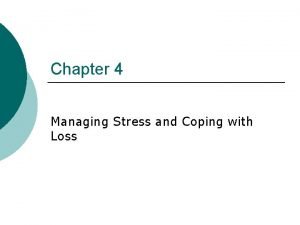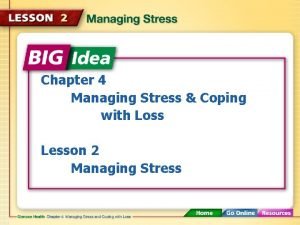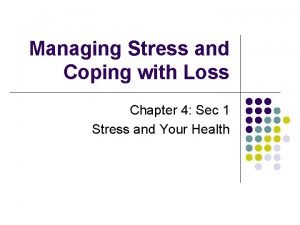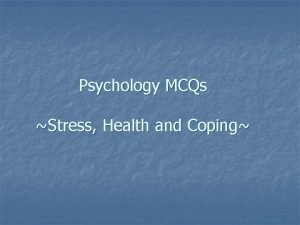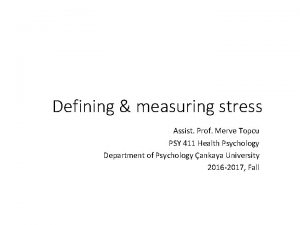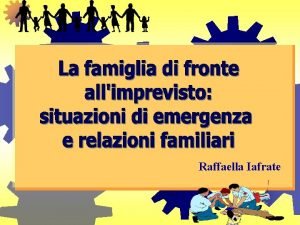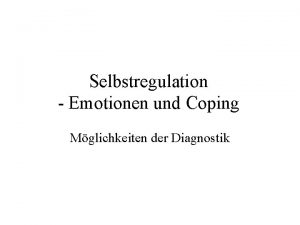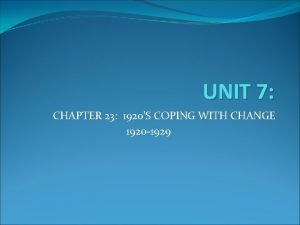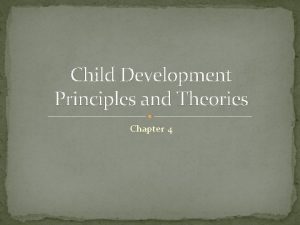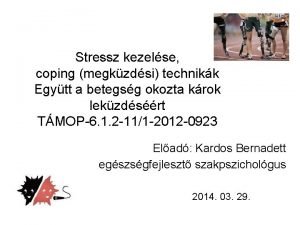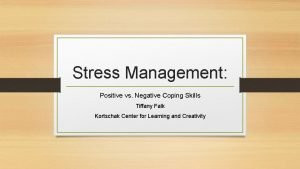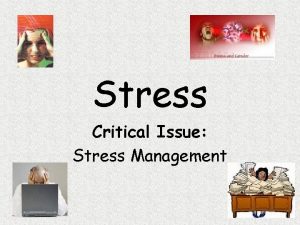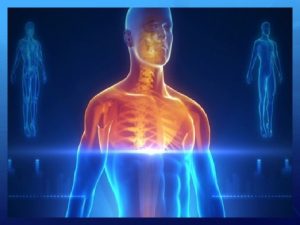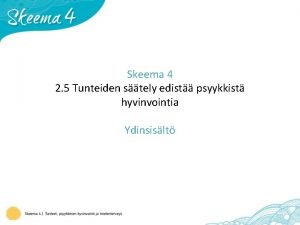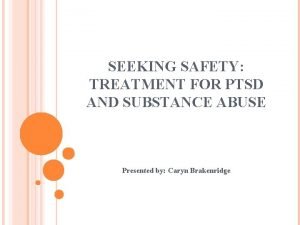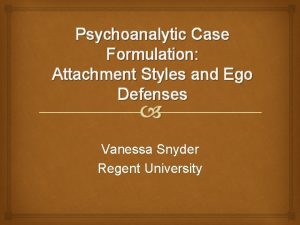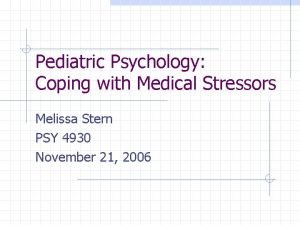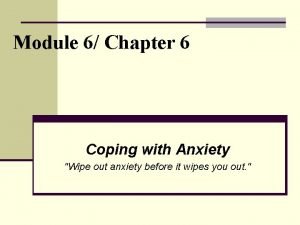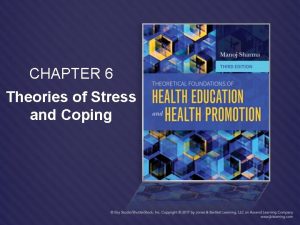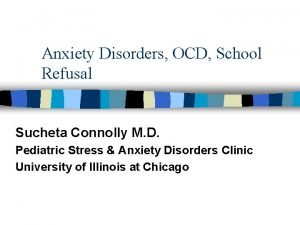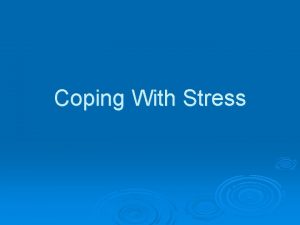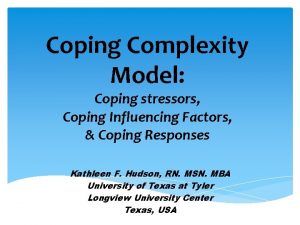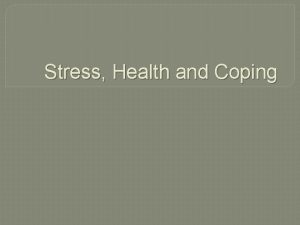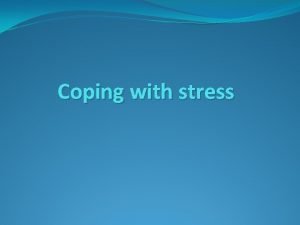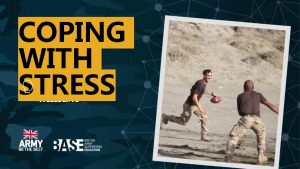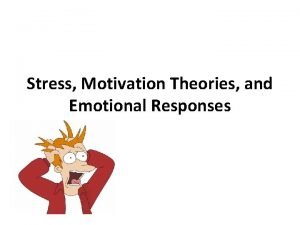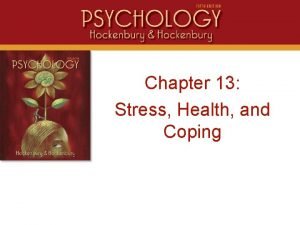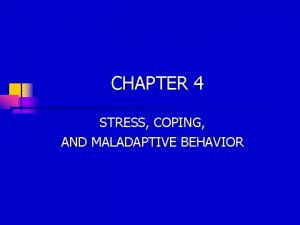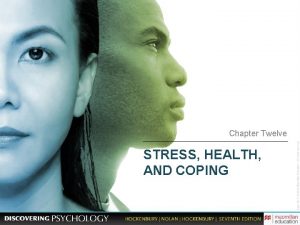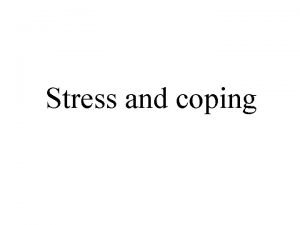CHAPTER 6 Theories of Stress and Coping Stress





































- Slides: 37

CHAPTER 6 Theories of Stress and Coping

• Stress is the response of – Body – Mind – Behaviors • As a result of – Encountering environmental events (stressors) – Interpreting these events – Making judgments about controlling or influencing these events © Maridav/Shuttterstock Stress

Types of Stressors • Life events or life change events – Discrete, observable, and objectively reportable events that require some social and/or psychological adjustment on the part of the individual – Recent: Within past year – Remote: Childhood events such as physical abuse, sexual abuse, neglect © Maridav/Shuttterstock

Types of Stressors (cont’d) • Chronic stressors – Events encountered in everyday life, more prevalent – Persistent life difficulties: Life events lasting more than 6 months (e. g. , long-term disability) – Role strains: From performing specific roles (parenting, working, being in a relationship, etc. ) or multiplicity of roles at the same time

Types of Stressors (cont’d) • Chronic stressors (cont’d) – Chronic strains: Response of one social group to another (e. g. , overt or covert, intentional or unintentional discriminatory behavior due to race, ethnicity, etc. ) – Community-wide strains: Stressors at an ecological level (e. g. , living in a high-crime neighborhood) – Daily hassles: Everyday problems (e. g. , standing in a queue, getting stuck in traffic)

Nonevents • Desired or anticipated events when they do not occur (e. g. , wanting to graduate but not having enough credits) • Desirable events that do not occur even though their occurrence is normative for people of a certain group (e. g. , as a college student, having an intimate friend of the opposite sex) • Not having anything to do (e. g. , getting bored) © Firma V/Shutterstock

Response-Based Model • Walter Cannon’s (1932) “fight or flight” response • General Adaptation Syndrome (Selye, 1936, 1974, 1982) – Alarm reaction – Stage of resistance – Stage of exhaustion • In 1980 s differentiated eustress (good stress) and distress (bad stress)

Event-Based Model • Holmes and Rahe (1967) constructed the Social Readjustment Rating Scale (SRRS) – 43 events – Calculated a life change unit (LCU) score • 150– 199 LCU score: 37% chance of these stressors leading to disease in next year • 200– 299 LCU score: 51% chance of these stressors leading to disease in next year • >300 LCU score: 79% chance of these stressors leading to disease in next year

Coping • Cope is derived from the Latin word colpus, meaning “to alter” • Dealing with and attempting to overcome problems and difficulties • In psychology used as – A thought process – A personality characteristic – In social context • “Coping” was officially used by Psychological Abstracts only in 1967

Historical Genesis of Coping • Sigmund Freud (1856– 1939) – Mechanisms of defense: devices that the mind uses in altering one’s perception of situations disturbing the internal milieu or mental balance • Alfred Adler (1930 s) – Defense mechanisms as protective against external threats or challenges • Anna Freud (1950 s) – Defense mechanisms as being protective for both internal and external threats

Historical Genesis (cont’d) • Norma Hann (1970 s) – Coping is purposive and involves choices; defense mechanisms are rigid and set – Coping focuses on present; defense mechanisms focus on past • Richard Lazarus (1980 s) – Transactional model—primary appraisal, secondary appraisal, coping reappraisal

Transactional Model • Primary appraisal • Am I OK or am I in trouble? • Judgment based on past; knowledge about oneself, about event; influence on others • Secondary appraisal • How much control do I have over the threat?

Transactional Model (cont’d) • Coping • Application of means identified • Reappraisal • Determining whether the original stressor has been negated

Model of Stress and Coping Figure 6 -2: Model of stress and coping.

Application of Transactional Model Figure 6 -3: How the transactional model can be used to develop healthy coping.

• Problem-focused coping – Based on one’s capability to think and alter the environmental event or situation • Emotion-focused coping – Based on focusing inward on altering the way one thinks or feels about a situation or an event © Sam 72/Shutterstock Types of Coping

Problem-Focused Coping • Examples of this strategy at the thought process level include: – Utilization of problem-solving skills – Interpersonal conflict resolution – Advice seeking – Time management – Goal setting – Gathering information about what is causing stress

Problem-Focused Coping (cont’d) • Examples of this strategy at the behavioral or action level include activities such as: – Joining a smoking cessation program – Compliance with a prescribed medical treatment – Adherence to a diabetic diet plan – Scheduling and prioritizing tasks for managing time

Emotion-Focused Coping • Examples of this strategy at the thought process level include: – Denying the existence of the stressful situation – Freely expressing emotions – Avoiding the stressful situation – Making social comparisons – Minimization or looking at the bright side of things

Emotion-Focused Coping (cont’d) • Examples of this strategy at the behavioral or action level include: – Seeking social support – Use of exercise – Relaxation – Meditation – Support groups

• Ways of Coping (WOC) checklist developed by Lazarus and Folkman – 68 items, eight categories: • Accepting responsibility (e. g. , criticizing or lecturing oneself) • Confrontational coping (e. g. , expressing anger) • Distancing (e. g. , trivializing the situation) • Escape avoidance (e. g. , wishing that the situation would go away) © Sue Smith/Shutterstock Measuring Coping

Measuring Coping (cont’d) • Ways of Coping checklist (cont’d) • Planned problem solving (e. g. , making a plan of action and following it) • Positive reappraisal (e. g. , changing or growing as a person in a good way) • Seeking social support (e. g. , talking to someone to find out about more about the situation) • Self-controlling (e. g. , keeping feelings to oneself)

Measuring Coping (cont’d) • WOC checklist—revised – Contains a list of 42 coping behaviors • Coping Orientations to Problems Experienced (COPE) scale by Carver – Twelve component scales for types of coping strategies: acceptance, active coping, denial, disengagement, humor, planning, positive reframing, religion, restraint, social support, self-distraction, and suppression of competing activities

Personality Characteristics • Hardiness • Suzanne Kobasa (1977) identified characteristics of highly stressed people among those who remained healthy and those who did not manifest any illness following stressful times – The belief of control, or the ability to influence the events of one’s experience – Commitment to the activities in life or feeling of deep involvement – Challenge to further development or anticipation of change

Personality Characteristics (cont’d) • Sense of coherence • Antonovsky has proposed that people who possess a higher sense of coherence tend to cope better in life – Comprehensible means that the person believes that the world around him or her is making some sense, there is some set structure, and there is some level of predictability

Personality Characteristics (cont’d) • Sense of coherence (cont’d) – Manageable implies the faith that one has in his or her ability to meet the various demands in life either one way or the other – Meaningfulness implies the belief that whatever one does, it has a purpose in life

Personality Characteristics (cont’d) • Optimism – Tendency to look at the brighter side of things and to expect positive outcomes from one’s actions – Carver and his colleagues studied the effects of optimism in breast cancer patients, heart rehabilitation patients, and people in other stressful situations and have found the beneficial effect of being optimistic on coping

Personality Characteristics (cont’d) • Type A and Type B personalities – American cardiologists Meyer Friedman and Ray Rosenman in their observations of heart disease patients have described two types of personalities – Type A people are characterized by time urgency, impatience, competitiveness, and hostility

Personality Characteristics (cont’d) • Type A and Type B personalities (cont’d) – Type B personalities are the opposites of Type A, as exemplified by having no time urgency, being cooperative, and having patient dispositions – Type A personalities have been found to demonstrate negative coping styles in terms of showing more negative physiological and psychological outcomes

Social Networks and Social Support • Social network: Consists of all the relationships that an individual has in his or her life • Social support: Relationships that are helpful to us

Types of Social Support (1) Emotional support, which entails providing understanding, love, caring, and reliance (2) Informational support, which entails providing information, guidance, and counsel (3) Instrumental support, which entails providing concrete assistance and support (4) Appraisal support, which entails providing evaluative assistance

Application Exercise • An example is from Japan, where Tomotsune and colleagues (2009) examined the association between sense of coherence and coping profile in Tsukuba Research Park City workers. • They used sense of coherence scale and Brief Scale for Coping Profile (BSCP) and mailed surveys to 20, 742 employees at educational and research institutions in Tsukuba Research Park City, Japan.

Application Exercise (cont’d) • The response rate was 57. 9%; 12, 009 individuals returned the surveys. • It was found that workers with higher sense of coherence scores used problem-focused coping, whereas workers with lower sense of coherence scores used emotion-focused coping. • Read this article and critique it in 250 words.

Application Exercise (cont’d) • In writing your critique, pay attention to: – Operationalization of independent and dependent variables – Instrumentation – Response rate – Data analysis – Data interpretation

Websites to Explore • American Institute of Stress – http: //www. stress. org/ • Sense of coherence and food selection – http: //www. nutritionj. com/content/4/1/9 • Sense of coherence scale – http: //jech. bmjjournals. com/cgi/content/abstra ct/59/6/460

Websites to Explore (cont’d) • Stress & disease: Contributions of Hans Selye – http: //home. cc. umanitoba. ca/~berczii/hans-selye/myteacher-hans-selye-and-his-legacy. html • Stress free net – http: //www. stressfree. com/ • Transactional model of stress and coping: University of Twente – http: //www. utwente. nl/cw/theorieenoverzicht/Theory%20 Clusters/Health%20 Communication/transactional_model _of_stress_and_coping/

Skill Building Activity © Bleakstar/Shutterstock • Identify any three constructs from the classical transactional model of stress coping. • Develop specific behavioral objectives corresponding to these constructs. • Describe specific activities you will use to modify these constructs in order to accomplish the objectives. • How can you enhance the predictability of the classical model?
 Leasiest
Leasiest Chapter 4 managing stress and coping with loss lesson 1
Chapter 4 managing stress and coping with loss lesson 1 Chapter 4 lesson 2 managing stress
Chapter 4 lesson 2 managing stress Managing stress and coping with loss
Managing stress and coping with loss Stress management mcqs
Stress management mcqs Stress appraisal and coping
Stress appraisal and coping Family stress and coping
Family stress and coping Stress strain coping support model
Stress strain coping support model Coping strategies for exam stress
Coping strategies for exam stress Copingstrategien
Copingstrategien Chapter 10 stress responses and stress management
Chapter 10 stress responses and stress management Chapter 4 lesson 3 coping with loss and grief
Chapter 4 lesson 3 coping with loss and grief Chapter 23 activity: coping with change, 1920-1929
Chapter 23 activity: coping with change, 1920-1929 True strain equation
True strain equation Abrafile
Abrafile Define axial stress
Define axial stress Child development principles and theories
Child development principles and theories Chapter 6 - theories of international trade and investment
Chapter 6 - theories of international trade and investment Karasekin malli
Karasekin malli Lazarus megküzdés
Lazarus megküzdés Positive vs negative coping skills
Positive vs negative coping skills Problem-focused coping examples
Problem-focused coping examples Reaction formation
Reaction formation Defenssit ja coping-keinot
Defenssit ja coping-keinot What is seeking safety
What is seeking safety Roof parapet details
Roof parapet details Attachment style chart
Attachment style chart Melissa stern psychologist
Melissa stern psychologist Anxiety goals nursing
Anxiety goals nursing Problem-focused coping examples
Problem-focused coping examples Coping definizione
Coping definizione Strong emotions can interfere with your ability to
Strong emotions can interfere with your ability to Stress definition psychology
Stress definition psychology Cpi coping model control phase
Cpi coping model control phase Coping mechanism
Coping mechanism Types of coping
Types of coping Ocd and school refusal
Ocd and school refusal Stratégie de coping
Stratégie de coping

